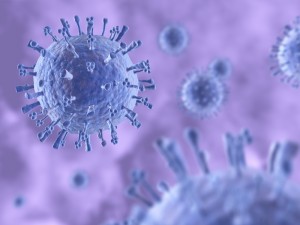Reports are growing that H1N1 targets young populations. According to the latest CDC reporting, there have been 43 flu-related deaths in the U.S. among perons under age 18, since August 30. A CDC spokesperson called these “very sobering statistics” given that only about 40 or 50 children usually die during an entire flu season.
A World Health Organization (WHO) conference that convened last week in Washington DC determined that the pathology of H1N1 is “strikingly different” from seasonal flu. “Many severe cases occur in previously healthy young people.” Predisposing factors for this are unclear.
Severe viral pneumonia was cited as a frequent cause of death. Respiratory failure and refractory (irreversible) shock were the most common causes of death. In severe cases, patients usually deteriorated around 3 to 5 days after the onset of symptopms, with many progressing on respiratory failure within 24 hours.
According to WHO conference participants, the groups at greatest risk included pregnant women, children under 2 years of age, and persons with lung disease. Disadvantaged minorities and indigeneous groups are also disproportionately predisposed to severe illness; this may be linked higher incidence of other risk factors. Obesity also appears to be linked to severe H1N1 cases.

WHO: Clinical features of severe cases of pandemic influenza
Washington Post: H1N1’s Links to Pneumonia Appear Clearer
Tagged: Care and Treatment, flu, h1n1, influenza, International News, swine flu
- Published:
- October 18, 2009 – 9:38 pm
- Author:
- By The Editor
- Categories:
-
- Comments:
A recent commentary in the Journal of the American Medical Association compares past clinical experience with H1N1 across four countries. Mexico, Canada, Australia and New Zealand involving intensive care units. Despite differences in normal care and mortality across the countries (which ranged from 14 to 41 percent), the studies signal what hospitals may confront in the coming months. Influenza outbreaks in Canada and Mexico lasted about 3 months. Peak flu periods lasted a few weeks during which time hospitals struggled to accomodate the surge in critically-ill patient volume. Patients tended to be “adolescents and young adults”, who rapidly progressed from flu symptions to respiratory failure. “Shock and multisystem organ failure were common.” The fact that large proportions of critically-ill patients did survive reflects the wide availability of antibiotics, antiviral medicines, and mechanical ventilation. However, authors caution that these experiences also underscore the need for planning on the part of hospitals and public health officials. The authors also raise troubling questions as to who might get life support if scarcities occur.
Editor’s note: The availability of H1N1 vaccines represents a new factor in this flu season and this may mitigate against expected patient surges.

JAMA: Preparing for the Sickest Patients With 2009 Influenza A(H1N1)
Health.com: Studies: Swine Flu Hits Young the Hardest
Tagged: Care and Treatment, flu, h1n1, influenza, International News, swine flu
- Published:
- October 14, 2009 – 6:31 pm
- Author:
- By The Editor
- Categories:
-
- Comments:
Recent findings published in the New England Journal of Medicine provide some insights into H1N1 vaccine side effects.
In clinical trials involving 120 persons involving a single dose of H1N1, there
were no deaths, no serious adverse events or other events that would have triggered the tests to end. The most common reactions reported by less than half (46%) of test participants within a seven day period included headaches, muscle pain, malaise (general discomfort), and injection site tenderness. Two participants reported severe muscle pains and nausea; these were reportedly resolved within 5-10 days. Three test participants did develop an influenza like illness, one of whom tested positive for the H1N1 2009 virus.
The H1N1 2009 vaccine is prepared using the same techniques as the seasonal flu vaccine. This involves injecting the virus strain into fertilized chicken eggs. It is then harvested, purified and developed into a vaccine.


NEJM: Response after One Dose of a Monovalent Influenza A (H1N1) 2009 Vaccine — Preliminary Report
Tagged: Care and Treatment, flu, h1n1, influenza, swine flu, US News, Vaccine Updates
- Published:
- October 11, 2009 – 11:45 pm
- Author:
- By The Editor
- Categories:
-
- Comments:

News accounts have reported lingering public suspicion about the safety of the H1N1 vaccine. Much of this coverage traces to a widely reported Associated Press poll conducted Oct. 1-5, that found 72 percent of those surveyed are worried about side effects. More than half say that those concerns wouldn’t stop them from getting the vaccine to protect their kids; the AP poll found that 38 percent of parents said they were unlikely to give permission for their kids to be vaccinated at school.
Rumors about the H1N1 vaccine are also spreading through spam and email hoaxes. Snopes.com showcases an example of one of these email fakes.
A Flu.Gov released an information product called “Myths and Realities” to address public concerns.


Tagged: Care and Treatment, flu, h1n1, influenza, swine flu, US News, Vaccine Updates
- Published:
- October 11, 2009 – 9:50 am
- Author:
- By The Editor
- Categories:
-
- Comments:
- Published:
- October 9, 2009 – 10:30 pm
- Author:
- By The Editor
- Categories:
-
- Comments:
09 Oct 2009
Reuters reports, according to the Center for Disease Control, pandemic H1N1 flu is spreading in several states at a time when there is normally little to no influenza.
CDC’s weekly FluView report revealed that 6.5 percent of all deaths in the last week of September were due to pneumonia and influenza. This is at the epidemic threshold. CDC also reported that there were 19 pediatric deaths (persons under age 18) in the week ending on Oct 3. This is the largest number of deaths among children and teenagers in a single week since the pandemic began.
As of 4 October 2009, there have been more than 375,000 laboratory confirmed cases of pandemic influenza H1N1 2009 and over 4500 deaths reported in the World Health Organization’s Situation Update.


Tagged: flu, h1n1, influenza, swine flu, US News
- Published:
- October 9, 2009 – 6:30 pm
- Author:
- By The Editor
- Categories:
-
- Comments:
08 Oct 2009
A study published in the New England Journal of Medicine and subsequently
reported in MedPage found that Intensive Care Units (ICUs) in New Zealand
and Australia admitted significantly more patients during their winter flu
season. Over the period of June 1 to August 31, 856 persons were
admitted to 187 ICUs. Of this number, 722 were confirmed with pandemic H1N1 influenza. During the same period in the preceeding four years, the two
countries admitted an average of 57 patients with viral pneumonia.

NEJM: Critical Care Services and 2009 H1N1 Influenza in Australia and New Zealand
MedPage: ICUs Down Under Hit Hard by H1N1 Pandemic Flu
Tagged: flu, h1n1, influenza, International News, swine flu
- Published:
- October 9, 2009 – 4:52 pm
- Author:
- By The Editor
- Categories:
-
- Comments:
28 Sep 2009
This story has not widely circulated. Two Dutch scientists reported in ProMed, that two patients diagnosed with H1N1 A 2009 virus had a mutation in the PB2 protein. This mutation had been historically associated with increased virulence in other influenza A strains. Both patients infected with this H1N1 mutation recovered. One patient had experienced mild flu symptoms; the other was reportedly treated with an antiviral medication. Preliminary experiments on ferrets using this H1N1 mutation did not indicate any increase in virulence. A followup on this story was reported in the Canadian Press.

ProMed, is a website and mailing list that provides early warning of outbreaks of emerging and re-emerging diseases
Tagged: flu, h1n1, influenza, International News, swine flu
- Published:
- October 9, 2009 – 12:01 am
- Author:
- By The Editor
- Categories:
-
- Comments:
- Published:
- October 7, 2009 – 6:02 pm
- Author:
- By The Editor
- Categories:
-
- Comments:







